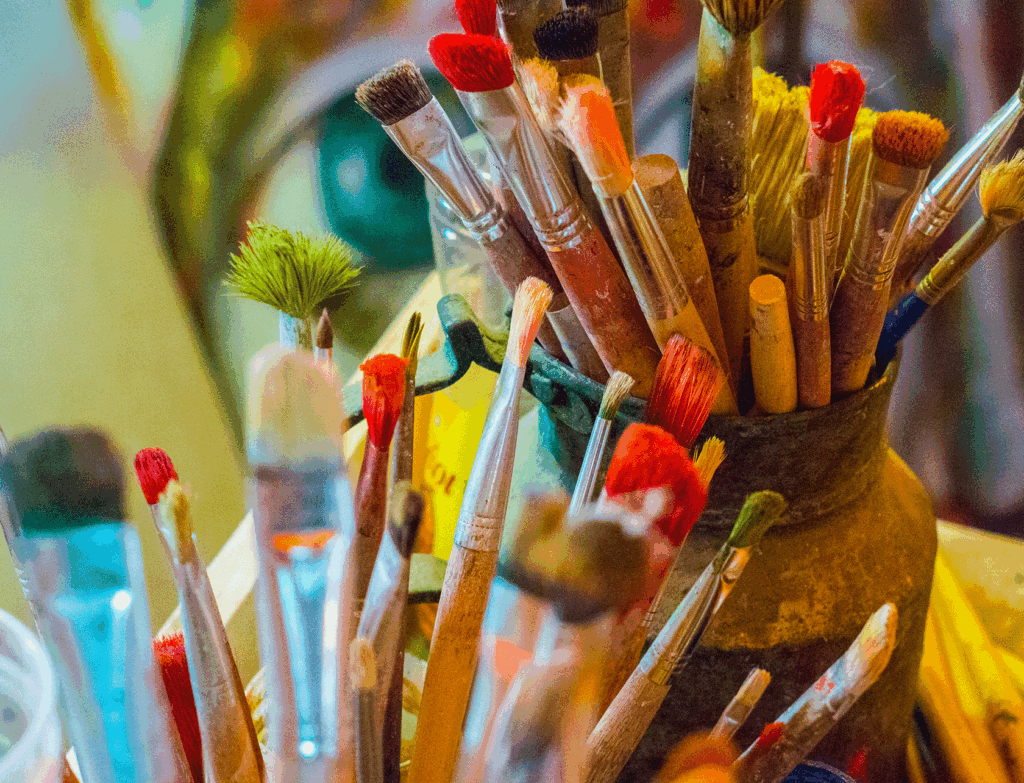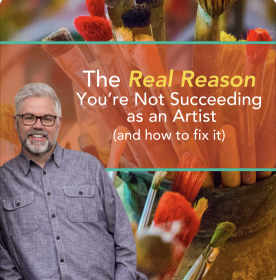
Entering the world of art as a beginner can be both exciting and daunting. One of the most pressing questions for emerging artists is: “How can I earn money from my art?” and better yet, “How can I balance my artistic passion with my desire to make money?” Don’t worry. Making a good living as an artist is absolutely, even though many artists don’t believe it.
One of the common challenges that artists face when trying to make money is the perception that it is nearly impossible to make a living from their art. This assumption is often based on the idea that only the most successful and wealthy artists are able to generate significant income, and even they are often only recognized after their death. However, we want to assure you that with the right approach and determination, it is possible to make a living as an artist, even while you are still alive.
Understanding the basics of art marketing and sales is crucial for turning your passion into profit. And balancing artistic passion with the desire for monetary gain can be a challenge for artists. However, it is achievable with the right approach. Artists can focus on finding ways to monetize their art without compromising their artistic vision. By exploring different avenues, creating a sustainable income, and staying true to their artistic passion, artists can strike a balance between their creative fulfillment and financial goals.
In this article, we’ll explore practical steps that beginners can take to start making money from their art, along with long-term strategies to build a sustainable career.
1. Start Small and Local
Begin by tapping into your local art scene. Participate in local art shows, fairs, and exhibitions. These events are a great way to get your work seen and start making sales. Don’t underestimate the power of local communities; often, your first buyers are those who know you and want to support local artists.
You may be wondering if you should sell your art at art fairs. My answer would be a resounding, yes! Art fairs are another fantastic opportunity to sell your art. They offer the in-person shopping experience that customers miss online, which can be highly valuable when it comes to art. By having your physical presence at a stall, you can engage shoppers and build relationships with potential buyers. Additionally, art fairs provide an excellent platform for networking not only with buyers but also with fellow artists and art industry professionals.
It’s important to note that selling at art fairs requires some planning and research. You need to account for all the objects you’ll need on the day and consider the potential costs involved, such as fees, materials, and transportation. Choosing the right art fair is crucial to maximize your chances of success.
Branching out to selling in-person at art fairs is a valuable experience for any artist. Even if you don’t make many sales, having people physically see your art and taking away your business card can lead to future purchases. So, don’t hesitate to explore the opportunities that art fairs present along with other avenues mentioned earlier. Remember, every successful artist was once a beginner. Start with small steps, build your confidence, and gradually expand your reach
2. Offer Commissioned Work
Many art lovers appreciate personalized, commissioned pieces. Start by offering to create custom artwork for friends, family, and local community members. Use your social networks to let people know that you’re open for commissions. Remember, word-of-mouth is a powerful tool in the art world.
3. Utilize Online Marketplaces
Platforms like Etsy, Saatchi Art, and Artfinder are excellent for artists looking to reach a broader audience. These sites cater to a large community of art buyers and make it easy to set up an online shop. While they take a commission, they handle many aspects of the selling process, making it easier for beginners.
4. Social Media as a Showcase
Social media platforms are not just for networking; they’re powerful tools for showcasing your work. Use platforms like Instagram, Pinterest, and Facebook to display your art. Regular posting, engaging with your followers, and using relevant hashtags can help you build an audience and attract buyers.
But many artists may ask “how can I use Instagram to sell my artwork?” That’s a great question! To effectively use Instagram to sell your artwork, follow these steps:
- Utilize Instagram’s shop tool: Instagram now offers a built-in shop feature that allows artists to directly advertise their work on the platform. Take advantage of this tool to showcase your artwork and make it easily accessible for potential buyers.
- Promote, promote, promote: Sharing your work consistently is key to gaining visibility and attracting buyers. Regularly post your art on Instagram and engage with your followers to build a dedicated community around your work.
- Build a strong online presence: Use Instagram as a platform to gather a community of art enthusiasts who appreciate and support your work. By creating a loyal following, you can effectively notify your audience when you have new pieces for sale or when you’re selling elsewhere.
- Leverage Instagram’s e-commerce focus: Instagram has increasingly focused on becoming an e-commerce platform. Keep up with these developments and make use of the tools and features provided. Stay knowledgeable about the latest updates, such as the introduction of Instagram Checkout, and adapt your selling strategies accordingly.
- Tell the story behind your artwork: Take advantage of Instagram’s visual nature to tell the story behind each piece of art you post. Share your inspiration, technique, and process to create a deeper connection with potential buyers, making your work more desirable and valuable.
- Collaborate with influencers and other artists: Partnering with influencers in the art community and collaborating with other artists can significantly boost your visibility and reach. Seek out influencers or artists with similar styles or interests and explore opportunities for joint promotions or supportive shoutouts.
- Engage with your audience: Actively interact with your followers by responding to comments, messages, and inquiries promptly and professionally. Engaging with your audience not only shows respect and appreciation for their support but also helps build trust and credibility, which can lead to sales.
- Use captivating visuals and compelling captions: Instagram is a highly visual platform, so make sure your photos showcase your artwork in the best possible light. Additionally, craft compelling captions that capture the attention of your audience, providing context, and inviting them to engage with your posts.
By implementing these strategies, you can effectively use Instagram to showcase and sell your artwork, reaching a broader audience and increasing your sales opportunities.
5. Teach Art Workshops
If you have a particular skill or technique, consider teaching it to others. Conducting workshops or classes can be a lucrative way to earn money while sharing your passion. Start with small, local workshops and then expand to online platforms as you gain confidence.
6. Print-on-Demand Services
Leveraging print-on-demand services like Society6 or Redbubble allows you to sell your art as prints, t-shirts, phone cases, and more. This method is great for artists who want to sell their art in various formats without the upfront costs of printing and stocking products.
7. Approach Local Businesses
Local cafes, restaurants, and businesses often look for unique artwork to decorate their spaces. Offer to display and sell your artwork in these venues. It’s a win-win: the business gets free decor, and you get exposure to potential buyers.
8. Join Online Art Contests
Participating in online art contests can be a way to earn money and gain recognition. Look for contests with cash prizes or opportunities for exhibitions. Even if you don’t win, these contests can be a great way to build your portfolio and get feedback on your work.
9. Create an Online Portfolio
An online portfolio is essential for showcasing your work professionally. Use platforms like WordPress or Squarespace to create a website that displays your art, provides contact information, and maybe even includes an online store.
10. Network with Other Artists
Networking with other artists can lead to collaborative projects, exhibitions, and sales opportunities. Join local or online art communities, attend gallery openings, and participate in artist meet-ups to build your network.
11. Seek Feedback and Improve
Always seek feedback on your work and be open to learning and improving. This approach will not only enhance your skills but also increase the marketability of your art.
12. Price Your Art for Profit
Determining the appropriate pricing for your artwork can be a complex task, but there are various factors to consider in order to establish a fair and profitable price. One method to gain a rough idea is by employing pricing formulas. However, it is crucial to customize and adjust the cost based on several considerations such as the pricing practices within your artist community, your level of experience, and the demand from your target audience.
To begin, researching how much similar artists are charging for their work can provide you with valuable insights. This allows you to ensure that you are not undervaluing your creations and skills. Undervaluing your work can diminish its perceived worth and have a detrimental impact on your artistic career in the long term. On the other hand, setting astronomically high price points may deter potential buyers quickly. Striking a balance is essential.
As a general guideline, it is important to ensure that you are still able to make a profit after considering all costs involved, such as materials and the time you invest in creating your artwork. To determine a fair price, take into account the expenses you incur during the creative process, the effort you exert, and the value you believe your art holds. Evaluating these factors will help you establish a suitable price that reflects both the value of your artwork and allows you to maintain a sustainable artistic career.
Remember, pricing your artwork is not just about earning money, but also about recognizing the significance of your talent and the worth of your creative output.
Starting out as an artist and learning how to earn money can be challenging, but it’s certainly achievable with persistence and creativity. Remember, every successful artist was once a beginner. Start with small steps, build your confidence, and gradually expand your reach.
For those who feel they need additional guidance, consider seeking the help of a mentoring program like the Created to Thrive Artist Mentoring Program. This program, led by experienced artist Matt Tommey, offers personalized guidance and support tailored to your artistic journey.
Visit the Created to Thrive Artist Mentorship Program to learn more about how this program can help you thrive as an artist, both creatively and financially. With the right approach and support, you can turn your artistic talent into a rewarding and profitable career.



Leave a Reply